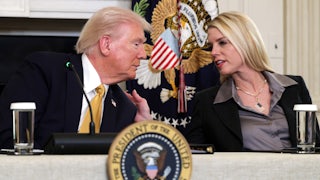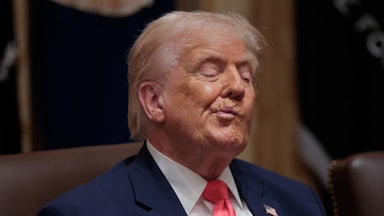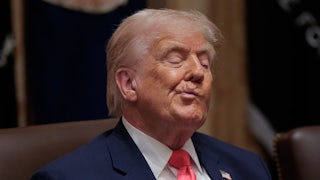May is Mental Health Awareness Month—a time when the nation is supposed to recommit to the mental health and well-being of millions struggling with depression, anxiety, trauma, and addiction. But instead of renewed support, the American people are getting a very different kind of message from the Trump administration: one of disinvestment, dismantling, and disregard.
More than one in five U.S. adults live with a mental illness—and over half receive no treatment. That’s not just a failure. It’s a warning. It’s also a statistic that we are not improving on. And while every administration should be expected to step up during Mental Health Awareness Month, this one is actively stepping away.
Here’s what that looks like in real terms:
The Trump administration’s proposed budget threatens to dismantle key supports for mental health care across the country. In April, it called for eliminating federal grants that fund school counselors and psychologists—resources that, since the pandemic, have been the only mental health support available to many students in under-resourced districts or without the means to seek private care. The budget also slashes funding for the Department of Health and Human Services targeting suicide prevention, overdose response, and youth mental health programs at a time of record need.
Most significantly, the administration seeks deep cuts to Medicaid—the nation’s largest mental health payer—by turning it into a block grant and imposing work requirements. Experts warn this would strip coverage from millions, especially those with serious mental illness, while allowing states to restrict benefits or add bureaucratic barriers. Other vital services are also on the chopping block. The 988 Suicide and Crisis Lifeline faces funding threats that could mean longer wait times for callers in crisis, while community behavioral health clinics that provide 24/7 care and keep people out of emergency rooms and jails risk being defunded. Meanwhile, experienced mental health experts are being replaced by political appointees, raising concerns that evidence-based policy is being sidelined in favor of ideology—just as the nation’s mental health crisis deepens.
Congress has a role here too. They can’t absolve themselves of their responsibility. Many of these programs—from school-based mental health to the 988 crisis line—were funded through bipartisan legislation. The money was appropriated. Are lawmakers now going to allow those investments to be quietly erased through backdoor administrative cuts? Will they step up to defend the programs they once championed—or let them die in silence?
This isn’t just bureaucratic reshuffling. It’s targeted sabotage. And it’s happening at the exact moment we should be doing more—not less.
The Biden administration had built on a decade of bipartisan momentum to invest in mental health. The Substance Abuse and Mental Health Services Administration, or SAMHSA, was strengthened. Medicaid waivers gave states more flexibility to expand care. The 988 crisis line launched nationally. Community-based programs grew. And the president declared, in his 2024 State of the Union, that “mental health is health”—reaffirming the federal government’s role in protecting and expanding it.
But the “Make America Healthy Again” agenda, now guiding federal policy under Trump, is aggressively undoing that progress. The strategy is clear: Shrink the federal footprint, offload responsibility to states, and hollow out the programs that make care accessible for people without wealth or privilege.
It would be one thing if mental health crises were abating and cases of serious psychosis were in decline. But the opposite is true, in part driven by stress from the Trump economy—from the ruinous tariffs to cuts in the social safety net. Financial stress is among the most common drivers of anxiety and depression. A recent Centers for Disease Control and Prevention/Census Bureau study found that adults facing economic hardship were three times more likely to experience serious psychological distress. A 2023 Kaiser Family Foundation report found that nearly 60 percent of low-income adults reported worsening mental health tied directly to economic pressures.
We’ve seen this before. During the Great Recession, “deaths of despair”—suicides, overdoses, alcohol-related illness—spiked. During Covid-19, similar patterns emerged. And when safety nets shrink, those deaths increase. Every dollar cut from Medicaid, housing aid, or food assistance translates into lives lost.
This isn’t theoretical. This is what happens when economic and health policies collide.
Yet the administration continues to downplay the urgency. Mental health remains a talking point for campaigns and press releases—but the actual policies tell another story. You don’t honor Mental Health Awareness Month by gutting the programs that keep people alive.
We are not in a post-crisis moment. The crisis is now. Youth suicide is rising. Drug overdoses killed over 100,000 Americans last year. Emergency rooms are full. Schools are overwhelmed. Veterans are dying by suicide. Those with the most serious mental illnesses, always forgotten in the system, are in even deeper trouble. And every one of these outcomes is made worse by policies that make care harder to get.
We are at a crossroads. One path builds on progress and makes mental health a permanent part of our health and economic infrastructure. The other treats it as expendable. A luxury. A side issue.
Our message is simple: Do not be fooled by lip service. Pay attention to the policy. This administration is choosing to walk away from mental health—during Mental Health Awareness Month, no less. And millions will pay the price.








